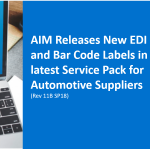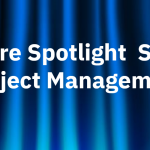Supply Chain Management Features
This Feature Spotlight blog series takes a deep dive into various features available in AIM’s ERP software solution, AIM Vision. Today’s Feature Spotlight blog focuses on best practices to get the most out of AIM Vision supply chain management features.
What is Supply Chain Management?
Supply chain management is the active coordination of the activities to produce and deliver products to the customer. It consists of five phases:
- Planning
- Sourcing
- Manufacturing
- Delivery
- Returns
Planning
The first phase, planning, aligns the supply chain with the financial plan of the company, which requires balancing resources with requirements. This phase includes activities such as demand and supply planning, demand forecasting, product pricing, inventory management, transportation logistics, assets and regulatory compliance.
Sourcing
The second phase, sourcing, supports the sourcing infrastructure and material acquisition processes. It includes how to manage inventory, the supplier network, supplier agreements, supplier performance, procurement, and credit and collections.
Manufacturing
The third phase, manufacturing, focuses on production activities. This phase includes production scheduling, packaging, product staging, product releasing, managing the production network/equipment/facilities, transportation (logistics) and product design.
Delivery
The fourth phase, delivery, includes order management, warehousing, delivery scheduling, transportation, and receiving orders from customers and invoicing them. It also includes management of finished inventories, assets, transportation, product life cycle, and importing and exporting.
Returns
The fifth and final phase, returns, involves the management of business rules, accepting and processing returned inventory, assets, transportation and regulatory requirements.
AIM’s Supply Chain Management
Maintaining traceability throughout the supply chain is a critical issue for manufacturers. The ability to monitor shipments, products and materials is a requirement for traceability and customer satisfaction. At the same time, a well-managed supply chain delivers cost savings by automating order processing, shipping and purchasing. A robust and agile supply chain reduces the risk of late shipments, logistical errors and material shortages.
For automotive suppliers, AIM Vision delivers the systems and solutions necessary for internal and customer MMOG/LE audits and reviews.
Using AIM’s flexible supply chain management features, enterprises manage customer demand, supplier cum variances and trends with release history comparisons. AIM Vision monitors shipping processes and logistics, including PPAP levels, returnable container tracking, shipping paperwork and ASNs.
Bar codes form a solid foundation for achieving tracking and transparency in the supply chain. AIM customers use its flexible label features to meet shipping requirements and print line side labels during the production process. Bar code labels include OEM and tier mandates, including inbound EDI, with more than 1800 available bar code label formats.
AIM Vision manages purchase orders, sends and receives supplier EDI, and coordinates purchase order requisitions for operational, maintenance and repair expenses. Quality features offer vendor metrics with historical data to meet delivery dates.
Using AIM mobility apps, users automate shipping and receiving directly on the plant floor with real-time visibility, accuracy and dock-side processing.
Best Practices in Supply Chain Management by Phase
Follow these best practices for each phase to get the most out of AIM’s supply chain management features.
Phase 1 of Supply Chain Management: Planning
- Utilize AIM’s quoting module to analyze and quote new jobs/projects according to your established standard/budgeted/quoted cost methodology used in production
- Manage all customer requirements within AIM’s Order Processing system (including EDI orders [862s, 830, Kanban], manual orders, spot buy) instead of managing what needs to be shipped offline in a spreadsheet
- Set up Customer/Item Number cross references so that EDI received for a customer part number is automatically converted to an order associated to your internal item number
- Monitor changes in customer demand using the Release History Net Change reports which show how customers have changed their orders over time
- Identify the Lead Time of each purchased part as an element of time, in calendar days, from the time an item is ordered to the time it is received from an outside supplier or from one’s own manufacturing facility, which will be used by the MRP system to time-phase planned orders
- Set up vendor Lead Time Days at the Item Level so that it defaults to the purchase orders and is calculated during MRP
- Set up vendor Lead Time at the Item Level so that it defaults to the purchase orders and is calculated during MRP
- Enter the Planned Weekly Usage for each part so that the inventory days on hand report can use the average daily quantity on hand
- Utilize the MRP Scheduling Sequence so that priority is given in scheduling to items with the lowest MRP scheduling sequence (instead of by alpha-numeric part number sequence)
- Enter both firm requirements and planning for manual orders, so MRP can calculate correctly based on forecasted demand
- Utilize the MRP to PO interface to automatically create release orders to your customers based upon the results of the Material Release Planning calculations
- Determine the optimal order frequency for components and raw materials and force MRP to calculate accordingly
- Enter release schedules with dates and quantities or have them automatically populated from MRP
- Enter both Firm and Planning requirements to give maximum visibility to your vendors of your upcoming materials needs
- Set up Scheduling Patterns to split the weekly release requirements into daily buckets
- Utilize Release Horizon to allow scheduling of group production runs for multiple weeks and save on setup/changeover times
- Utilize Run Lot Sizes so that MRP always schedules you to produce in full container quantities
- Utilize the Material Allowance % within the Bill of Material (BOM) to account for non-perfect usage of material and to make sure to order more or “extra” material necessary to complete production orders
- Set up Scheduling Patterns to split the monthly forecast release requirements into weekly buckets
- Specify a Maximum Net Available quantity so that you can identify too much inventory on-hand using the MRP Over/Under reports
- Analyze Sales Forecasts and compare them to Sales Analysis to gain insight on customers that forecast higher than shipment volumes creating excess inventory and lost revenue
- Use the Product Line indicator to monitor all the products within a given platform or product line for analysis of sales and costs
- Manage selling price changes in a timely manner for all parts sold so that you can analyze the selling price over time
- Utilize the Sales Forecast Reports to estimate revenues in a future period using demand and a set of forecast code rules
- Utilize the Sales and Operations Planning tool in AIM to estimate asset utilization for future periods
- Set up multiple forecast codes to be able to do “what if” scheduling
Phase 2 of Supply Chain Management: Sourcing
- Use AIM’s robust process of min/max by item number or inventory value by item type to help manage inventory level changes and control costs
- Use the Inventory Obsolescence Report to help control obsolete material or slow-moving stock
- Create a Scrap Allowance Percent to schedule a designated amount of overproduction to account for anticipated scrap
- Utilize AIMs Manufacturing Execution System and Container Movement transactions to record production and inventory transactions in real time
- Use AIM Mobility MES tablet app to post real-time production transactions into AIM directly from the work cell
- Receive all production materials via AIM to maintain inventory levels and track expenditures
- Identify the Minimum Order quantity to purchase parts without being penalized for not ordering with economies of scale
- Implement Order Lot Size to work in conjunction with Minimum Order Quantity to order in standard pack or full coil increments
- Set up Safety Stock values (quantities) on items to set an artificial zero point which will trigger re-ordering of product if inventory levels fall below the safety stock level
- Set up Safety Days on items so that products are produced/received a certain number of days before they are absolutely needed
- Set up the Minimum Order quantity for components and raw materials in AIM so that MRP will use this minimum order amount in the MRP calculations and not force small-sized orders of components
- Use Order Lot Size in conjunction with Minimum Order Quantity to receive components by full box or standard coil size
- Utilize the Reusable Scrap BOM capability which allows for scrap parts to be ground up and accounted for as raw material that can be used in the future
- Use the Reset Blanket Cums feature to roll back accum quantities, on purchase orders issued to your vendors, to zero each year to align with the major OEMs
- Utilize the Part Routing/BOM to track parts at outside service suppliers like paint, plate, heat treat, and/or contract assembly
- Use AIM’s OV Processing module to track parts you send to outside vendors for secondary processing
- Utilize the Outside Process Vendor Transfer feature to manage multiple, back-to-back Outside Process steps
- Use AIM Vendor Performance Tracking by comparing receiving records with purchasing requirements for both quantities and dates
- Implement Vendor / Supplier EDI to the supply base to satisfy MMOG requirements
- Issue Purchase Orders (or releases) to your vendors through AIM via paper documents, e-mails and/or vendor EDI
- Set up Production Patterns to plan for material to be received only on certain days within a week
- Create discrete Outside Processing original type release schedules to monitor OV Processor shipment delivery performance against set delivery targets
- Use container tracking at outside vendor processing to ensure that you are not “losing” containers (from your inventory) when sending parts to the outside processor
- Identify a Primary Vendor for purchased parts to facilitate MRP to PO processing
- Set up all EDI capable trading partners in AIM and utilize AIM’s library of over 450+ trading partners
Phase 3 of Supply Chain Management: Manufacturing
- Report Overall Equipment Effectiveness (OEE) using AIM’s built-in report to highlight your worst performing workcenters and focus on them for improvement
- Use warehouse locations to separate your inventory in your financial reporting
- Use warehouse control, in conjunction with outside processing, to identify parts at the different locations/vendors and to easily see how many parts are at each vendor
- Use the Warehouse Transfer function to move inventory (and lots) from one warehouse to another for inventory value reporting by warehouse
- Use AIM’s Location Tracking System to record designated storage locations for Raw Material and WIP
- Set up Production Patterns to plan production on only certain days within a week
- Use Container Movement to record real-time inventory transactions
- Post inventory adjustments to GL to generate GL distributions when the system processes Inventory Adjustment Entry, Lot Adjustment Entry, Variance Count Update, Container Movement and Customer Returns
- Use AIMs disposition function to put manufactured products on hold and/or to to keep inventory of produced product and raw material as accurate as possible
- Set up iDashboards from the AIM Data Depot to monitor key performance indicators (KPIs) within your manufacturing facility
- Use AIM Container IDs and Container BOMs to manage customer returnable containers, top caps, skid pallet bottoms, corner posts, etc.
- Add Notes to each Item Master to record key characteristics about the part that can be viewed from the production tablets lineside when using Mobility MES
- Associate Notes to each production routing step so that operators can view them when using mobility MES at the workcenter
- Use the Part Routing/BOM to maintain an accurate Bill of Materials of each item being produced
- Utilize the Digital Whiteboard scheduling tool that can show both a Queue View and Gantt view of the production schedule and can also display current production status at each workcenter
- Route all production steps through a primary workcenter, to better identify overloaded capacity
- Utilize the Minimum Run Quantity to specify the least number of parts to be scheduled at one time to amortize your production set-ups
- Route production steps through a list of alternate workcenters which will be used to schedule in a finite scheduling mode
- Utilize warehouse controls within the Bill of Material to relieve from specific warehouses to determine which parts are using how much components
- Indicate the number of Pieces Per Cycle in the Part Routing for situations where a single hit will produce multiple parts
- Include the required Setup Hours in the Part Routing/BOM for each step of the manufacturing process so that the production schedule can properly accommodate for the set-up time
- Set up Queue Hours so that the schedule can require parts to queue for a certain amount of time before processing them through a routing step
- Set up Post Queue Hours so that the schedule can require parts to queue for a certain amount of time after processing them through a routing step
- Set up an Overlap Indicator and Overlap Amount so that the schedule is aware of progressive manufacturing operations where each cycle does not necessarily create a finished part (i.e., single piece flow)
- Set a Minimum Run Quantity so that set-ups are amortized over longer production runs and the schedule doesn’t set you up for a changeover after a minimal number of pieces
- Set up workcenter departments to assist in scheduling (i.e., so that some items can be scheduled by workcenter department, not specific workcenter)
- Use the Digital Whiteboard as a visual scheduling tool for the production floor
- Utilize the system generated Material Requirements Planning (Generate MRP) on a regular frequency to schedule all production at all workcenters and to schedule all purchased part orders
- Use the Staging Manager to create ship orders and simplify the process
- Scan all labels of a shipment during the staging process to ensure every order is complete and correct prior to processing the shipment
- Utilize the AIM Mobility Shipping App to scan and verify staged orders, ship order updating, print paperwork, update shipper and send ASNs directly from the tablet on the shipping floor. (You must login to AIM Vision to send the ASN via a tablet.)
Phase 4 of Supply Chain Management: Delivery
- Manage returnable container quantities on hand by increasing the quantity on hand using the Container Tracking Entry feature
- Regularly manage customer orders and delete expired orders so that your team doesn’t accidently ship against n expired
- Enter Ship Codes into AIM so that the shipping report reflects only the days of actual shipments (not the requirement date)
- Use the Certificate of Origin Info. Entry which includes the Harmonized Code and Traced Value to simplify international shipments between the U.S., Canada and Mexico
- Print all export paperwork and Canadian invoices out of AIM to utilize standard and border compliant forms
- Print customs (export) paperwork specific for a customs broker directly from AIM
- Actively manage customer orders and past due quantities so that the demand shown in AIM is always actual and correct
- Manage customer CUMs and roll them when needed so that your demand in AIM is always correct
- Utilize the EDI Requirements Adjustment utility to correct inaccuracies with EDI from your customers
- Set up Standard Pack quantities on all orders, so that AIM can round each order to the nearest standard pack even if the customer is not doing so
- Label product with the customer compliant container serial label, master label, mixed label, destination label, part label, and quick receive label generated from AIM
- Utilize effective dates in BOMs to indicate when a component will become part of the BOM and when it will no longer be part of the BOM
- Actively maintain and manage Kanban trading partners and the necessary steps to process a shipment using Kanbans
- Use Auto Freight Invoicing to invoice the customer for freight by a base cost, cost per container, cost per weight or weight overage cost
- Use Third Party Freight setup to print the correct address on the Bill of Lading (BOL) and direct the billing to the proper location
- Utilizing the Expedited Shipments fields to mark expedited shipments as such and assign a reason for the expedite which then allows for reporting on expedites and associated reasons
Phase 5 of Supply Chain Management: Returns
- Use Customer Concerns Entry to record all product being returned from your customers and any complaints from your customers, and to issue your customer a return material authorization number
- Record Inventory Returns and Customer Returns in AIM so that you can report on them, share these issues with the team, and work to correct the root causes
In conclusion, AIM Vision ERP delivers robust supply chain management in real time with transparency for planning, forecasting and decision-making.
Looking for consulting help to get the most out of your AIM ERP? Contact us today.



